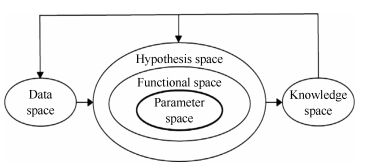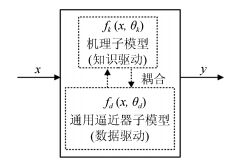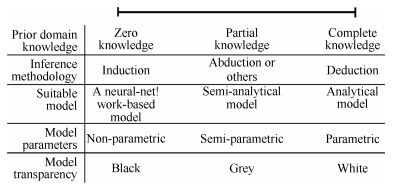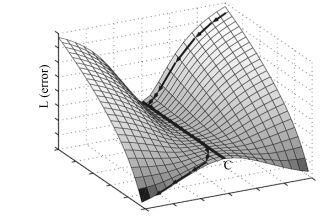|
[1]
|
Matzkin R L. Nonparametric identification. Handbook of Econometrics. New York:Elsevier Science Ltd, 2007.
|
|
[2]
|
Dufour J M, Hsiao C. Identification. The New Palgrave Dictionary of Economics. London:Palgrave Macmillan Ltd., 2008.
|
|
[3]
|
Koopmans T C. Identification problems in economic model construction. Econometrica, 1949, 17(2):125-144 doi: 10.2307/1905689
|
|
[4]
|
Aldrich J J. Haavelmo's identification theory. Econometric Theory, 1994, 10:198-219 doi: 10.1017/S026646660000829X
|
|
[5]
|
Zadeh L A. On the identification problem. IRE Transactions on Circuit Theory, 1956, 3(4):277-281 doi: 10.1109/TCT.1956.1086328
|
|
[6]
|
Zadeh L A. From circuit theory to system theory. Proceedings of the Institute of Radio Engineers, 1962, 50(5):856-865 https://people.eecs.berkeley.edu/~zadeh/papers/From%20Circuit%20Theory%20to%20System%20Theory-May1962.pdf
|
|
[7]
|
Ljung L. System Identification:Theory for the User (Second Edition). Upper Saddle River, NJ:Prentice-Hall, 1999.
|
|
[8]
|
Chen H F, Guo L. Identification and Stochastic Adaptive Control. Boston, MA:Birkhauser, 1991.
|
|
[9]
|
Walter E, Pronzato L. Identification of Parameter Models from Experimental Data. London:Springer-Verlag, 1997.
|
|
[10]
|
周彤.面向控制的系统辨识导论.北京:清华大学出版社, 2002.Zhou Tong. Introduction to Control-oriented System Identification. Beijing:Tinghua University Press, 2002.
|
|
[11]
|
Miao H Y, Xia X H, Perelson A S, Wu H L. On identifiability of nonlinear ODE models and applications in viral dynamics. SIAM Review, 2011, 53(1):3-39 doi: 10.1137/090757009
|
|
[12]
|
王乐一, 赵文虓.系统辨识:新的模式、挑战及机遇.自动化学报, 2013, 39(7):933-942 http://www.aas.net.cn/CN/abstract/abstract18122.shtmlWang Le-Yi, Zhao Wen-Xiao. System identification:new paradigms, challenges, and opportunities. Acta Automatica Sinica, 2013, 39(7):933-942 http://www.aas.net.cn/CN/abstract/abstract18122.shtml
|
|
[13]
|
Ljung L. Perspectives on system identification. Annual Reviews in Control, 2010, 34(1):1-12 doi: 10.1016/j.arcontrol.2009.12.001
|
|
[14]
|
Ran Z Y, Hu B G. Determining structural identifiability of parameter learning machines. Neurocomputing, 2014, 127:88-97 doi: 10.1016/j.neucom.2013.08.039
|
|
[15]
|
Hu B G, Qu H B, Wang Y, Yang S H. A generalizedconstraint neural network model:associating partially known relationships for nonlinear regressions. Information Sciences, 2009, 179(12):1929-1943 doi: 10.1016/j.ins.2009.02.006
|
|
[16]
|
Koopmans T C, Reiersol O. The identification of structural characteristics. Annuals of Mathematical Statistics, 1950, 21(2):165-181 doi: 10.1214/aoms/1177729837
|
|
[17]
|
Bellman R, Aström K J. On structural identifiability. In:Proceedings of the Mathematical Biosciences. Amsterdam:Elsevier, 1970, 7:329-339 http://www.sciencedirect.com/science/article/pii/002555647090132X
|
|
[18]
|
Amari S I, Nagaoka H. Methods of Information Geometry. New York:AMS and Oxford University Press, 2000.
|
|
[19]
|
Watanabe S. Asymptotic equivalence of Bayes cross validation and widely applicable information criterion in singular learning theory. Journal of Machine Learning Research, 2010, 11:3571-3594 http://citeseerx.ist.psu.edu/viewdoc/summary?doi=10.1.1.407.7976
|
|
[20]
|
Watanabe S. Algebraic geometrical methods for hierarchical learning machines. Neural Networks, 2001, 14(8):1049-1060 doi: 10.1016/S0893-6080(01)00069-7
|
|
[21]
|
Watanabe S. Algebraic geometry of singular learning machines and symmetry of generalization and training errors. Neurocomputing, 2005, 67:198-213 doi: 10.1016/j.neucom.2004.11.037
|
|
[22]
|
Watanabe S. Almost all learning machines are singular. In:Proceedings of the 2007 IEEE Symposium on Foundations of Computational Intelligence. Piscataway, USA:IEEE, 2007.
|
|
[23]
|
Watanabe S. Algebraic Geometry and Statistical Learning Theory. Cambridge:Cambridge University Press, 2009.
|
|
[24]
|
Chen A M, Lu H, Hecht-Nielsen R. On the geometry of feedforward neural network error surfaces. Neural Computation, 1993, 5(6):910-927 doi: 10.1162/neco.1993.5.6.910
|
|
[25]
|
Kurková V, Kainen P C. Functionally equivalent feedforward neural networks. Neural Computation, 1994, 6(3):543-558 doi: 10.1162/neco.1994.6.3.543
|
|
[26]
|
Sussmann H J. Uniqueness of the weights for minimal feedforward nets with a given input-output map. Neural Networks, 1992, 5(4):589-593 doi: 10.1016/S0893-6080(05)80037-1
|
|
[27]
|
Bishop C M. Pattern Recognition and Machine Learning. Berlin:Springer, 2006
|
|
[28]
|
Henao R, Winther O. Sparse linear identifiable multivariate modeling. Journal of Machine Learning Research, 2011, 12:863-905 https://www.coursehero.com/file/17054240/Sparse-Linear-Identifiable-Multivariate-Modeling/
|
|
[29]
|
Walter E, Lecourtier Y. Unidentifiable compartment models:what to do? Mathematical Biosciences, 1981, 56(1-2):1-25 doi: 10.1016/0025-5564(81)90025-0
|
|
[30]
|
Wu H L, Zhu H H, Miao H Y, Perelson A S. Parameter identifiability and estimation of HIV/AIDS dynamic models. Bulletin of Mathematical Biology, 2008, 70(3):785-799 doi: 10.1007/s11538-007-9279-9
|
|
[31]
|
Xia X, Moog C H. Identifiability of nonlinear systems with application to HIV/AIDS models. IEEE Transactions on Automatic Control, 2003, 48(2):330-336 doi: 10.1109/TAC.2002.808494
|
|
[32]
|
Fortunati S, Gini F, Greco M S, Farina A, Graziano A, Giompapa S. On the identifiability problem in the presence of random nuisance parameters. Signal Processing, 2012, 92(10):2545-2551 doi: 10.1016/j.sigpro.2012.04.004
|
|
[33]
|
Yang S H, Hu B G, Cournède P H. Structural identifiability of generalized-constraint neural network models for nonlinear regression. Neurocomputing, 2008, 72(1-3):392-400 doi: 10.1016/j.neucom.2007.12.013
|
|
[34]
|
Rothenberg T J. Identification in parametric models. Econometrica, 1971, 39(3):577-591 doi: 10.2307/1913267
|
|
[35]
|
Cover T M, Thomas J A. Elements of Information Theory (Second Edition). Chichester:Wiley-Blackwell, 1991.
|
|
[36]
|
Bowden R J. The theory of parametric identification. Econometrica, 1973, 41:1069-1074 doi: 10.2307/1914036
|
|
[37]
|
Ran Z Y, Hu B G. Determining parameter identifiability from the optimization theory framework:a Kullback-Leibler divergence approach. Neurocomputing, 2014, 142:307-317 doi: 10.1016/j.neucom.2014.03.055
|
|
[38]
|
Luenberger D G, Ye Y Y. Linear and nonlinear programming. International Series in Operations Research & Management Science (Second Edition). New Jersey:AddisonWesley, 1984
|
|
[39]
|
Ran Z Y, Hu B G. An identifying function approach for determining parameter structure of statistical learning machines. Neurocomputing, 2015, 162:209-217 doi: 10.1016/j.neucom.2015.03.050
|
|
[40]
|
Hochwald B, Nehorai A. On identifiability and informationregularity in parameterized normal distributions. Circuits Systems Signal Processing, 1997, 16(1):83-89 doi: 10.1007/BF01183177
|
|
[41]
|
Stoica P, Ng B C. On the Cramér-Rao bound under parametric constraint. IEEE Signal Processing Letters, 1998, 5(7):177-179 doi: 10.1109/97.700921
|
|
[42]
|
Yao Y W, Giannakis G. On regularity and identifiability of blind source separation under constant modulus constraints. IEEE Transactions on Signal Processing, 2005, 53(4):1272-1281 doi: 10.1109/TSP.2005.843718
|
|
[43]
|
Murphy K P. Machine Learning:A Probabilistic Perspective. Cambridge:MIT Press, 2012.
|
|
[44]
|
Bishop C M. Pattern Recognition and Machine Learning. Berlin:Springer, 2006.
|
|
[45]
|
Paulino C D M, de Bragança Pereira C A. On identifiability of parametric statistical models. Journal of the Italian Statistical Society, 1994, 3(1):125-151 doi: 10.1007/BF02589044
|
|
[46]
|
Ernesto S M, Fernando Q. Consistency and identifiability, revisited. Brazilian Journal of Probability and Statistics, 2002, 16(1):99-106 http://www.redeabe.org.br/bjpspublishedpapers_volume16_1_pp099-106.pdf
|
|
[47]
|
Boyd S, Vandenberghe L. Convex Optimization. Cambridge:Cambridge University Press, 2004.
|
|
[48]
|
Catchpole E A, Morgan B J T, Freeman S N. Estimation in parameter redundant models. Biometrika, 1998, 85(2):462-468 doi: 10.1093/biomet/85.2.462
|
|
[49]
|
Catchpole E A, Morgan B J T. Deficiency of parameterredundant models. Biometrika, 2001, 88(2):593-598 doi: 10.1093/biomet/88.2.593
|
|
[50]
|
Catchpole E A, Morgan B J T. Detecting parameter redundancy. Biometrika, 1997, 84(1):187-196 doi: 10.1093/biomet/84.1.187
|
|
[51]
|
Amari S I, Park H, Ozeki T. Singularities affect dynamics of learning in neuromanifolds. Neural Computation, 2006, 18(5):1007-1065 doi: 10.1162/neco.2006.18.5.1007
|
|
[52]
|
Hu B G. What are the differences between Bayesian classifiers and mutual information classifiers. IEEE Transactions on Neural Networks and Learning Systems, 2014, 25(2):249-264 doi: 10.1109/TNNLS.2013.2274799
|
|
[53]
|
Ran Z Y, Hu B G. An identifying function approach for determining structural identifiability of parameter learning machines. In:Proceedings of International Joint Conference on Neural Networks. Beijing:IEEE, 2014.
|
|
[54]
|
Jiang H H, Pollack K H, Brownie C, Hightower J E, Hoeing J E, Hearn W S. Age-dependent tag return models for estimating fishing mortality, natural mortality and selectivity. Journal of Agricultural, Biological, and Environmental Statistics, 2007, 12(2):177-194 doi: 10.1198/108571107X197382
|
|
[55]
|
Saccomani M P, Audoly S, Bellu G, D' Angiò L. Examples of testing global identifiability of biological and biomedical models with the DAISY software. Computers in Biology and Medicine, 2010, 40(4):402-407 doi: 10.1016/j.compbiomed.2010.02.004
|
|
[56]
|
Dasgupta A, Self S G, Gupta S D. Unidentifiable parametric probability models and reparameterization. Journal of Statistical Planning and Inference, 2007, 137(11):3380-3393 doi: 10.1016/j.jspi.2007.03.018
|
|
[57]
|
Evans N D, Chappell M J. Extensions to a procedure for generating locally identifiable reparameterisations of unidentifiable systems. Mathematical Biosciences, 2000, 168(2):137-159 doi: 10.1016/S0025-5564(00)00047-X
|
|
[58]
|
Little M P, Heidenreich W F, Li G Q. Parameter identifiability and redundancy in a general class of stochastic carcinogenesis models. PLoS ONE, 2009, 4:e8520 doi: 10.1371/journal.pone.0008520
|
|
[59]
|
Little M P, Heidenreich M F, Li G. Parameter identifiability and redundancy:theoretical considerations. PLoS ONE, 2010, 5:e8915 doi: 10.1371/journal.pone.0008915
|
|
[60]
|
Nakajima S, Sugiyama M. Implicit regularization in variational Bayesian matrix factorization. In:Proceedings of the International Conference on Machine Learning. Piscataway, USA:IEEE, 2010.
|
|
[61]
|
Kiraly F, Tomioka R. A combinatorial algebraic approach for the identifiability of low-rank matrix completion. In:Proceedings of the 29th International Conference on Machine Learning. Edinburgh, Scotland:ACM, 2012. 755-762
|
|
[62]
|
Dacunha-Castelle D, Gassiat É. Testing in locally conic models, and application to mixture models. Probability and Statistics, 1997, 1:285-317 doi: 10.1051/ps:1997111
|
|
[63]
|
Brockett R W. Some geometric questions in the theory of linear systems. In:Proceedings of the IEEE Conference on Decision and Control including the 14th Symposium on Adaptive Processes. New York:IEEE, 1975. 71-76 doi: 10.1007%2F978-1-4615-5223-9_1.pdf
|
|
[64]
|
Vapnik V N. The Natural of Statistical Learning Theory. New York:Springer, 1995.
|
|
[65]
|
Vapnik V N. Statistical Learning Theory. New York:John Wiley and Sons, 1998.
|
|
[66]
|
White H. Learning in artificial neural networks:a statistical perspective. Neural Computation, 1989, 1(4):425-464 doi: 10.1162/neco.1989.1.4.425
|
|
[67]
|
Hagiwara K. On the problem in model selection of neural network regression in overrealizable scenario. Neural Computation, 2002, 14(8):1979-2002 doi: 10.1162/089976602760128090
|
|
[68]
|
Murata N, Yoshizawa S, Amari S I. Network information criterion-determining the number of hidden units for an artificial network model. IEEE Transactions on Neural Networks, 1994, 5(6):865-872 doi: 10.1109/72.329683
|
|
[69]
|
Akaike H. A new look at the statistical model identification. IEEE Transactions on Automatic Control, 1974, 19(6):716-723 doi: 10.1109/TAC.1974.1100705
|
|
[70]
|
Duda R O, Hart P E, Stork D G. Pattern Classification. New York:Wiley, 2001.
|
|
[71]
|
Amari S I. Natural gradient works efficiently in learning. Neural Computation, 1998, 10(2):251-276 doi: 10.1162/089976698300017746
|
|
[72]
|
Yang H H, Amari S I. Complexity issues in natural gradient descent method for training multi-layer perceptrons. Neural Computation, 1998, 10(8):2137-2157 doi: 10.1162/089976698300017007
|
|
[73]
|
Rattray M, Saad D. Analysis of natural gradient descent for multilayer neural networks. Physical Review E, 1999, 59(4):4523-4532 doi: 10.1103/PhysRevE.59.4523
|
|
[74]
|
Rattray M, Saad D, Amari S I. Natural gradient descent for online learning. Physical Review Letters, 2000, 81(24):5461-5464 doi: 10.1103/PhysRevLett.81.5461
|
|
[75]
|
Cousseau F, Ozeki T, Amari S I. Dynamics of learning in multilayer perceptrons near singularities. IEEE Transactions on Neural Networks, 2008, 19(8):1313-1328 doi: 10.1109/TNN.2008.2000391
|
|
[76]
|
Wei H K, Zhang J, Cousseau F, Ozeki T, Amari S I. Dynamics of learning near singularities in layered networks. Neural Computation, 1989, 20(3):813-843 http://www.docin.com/p-513451782.html
|
|
[77]
|
Weyl H. On the volume of tubes. American Journal of Mathematics, 1939, 61(2):461-472 doi: 10.2307/2371513
|
|
[78]
|
Fukumizu K. Generalization error of linear neural networks in unidentifiable cases. In:Proceedings of the 10th International Conference on Algorithmic Learning Theory. Berlin:Springer-Verlag, 1999. 51-62
|
|
[79]
|
Liu X, Shao Y Z. Asymptotics for likelihood ratio tests under loss of identifiability. Annals of Statics, 2003, 31(3):807-832 doi: 10.1214/aos/1056562463
|
|
[80]
|
Ran Z Y, Hu B G. Parameter identifiability in statistical machine learning:a review. Neural Computation, 2017, 29(5):1151-1203 doi: 10.1162/NECO_a_00947
|
|
[81]
|
He K M, Zhang X Y, Ren S Q, Sun J. Delving deep into rectifiers:surpassing human-level performance on imageNet classification. In:Proceedings of the 2015 IEEE International Conference on Computer Vision. Santiago, Chile:IEEE, 2015. 1026-1034
|
|
[82]
|
胡包钢, 王泳, 杨双红, 曲寒冰.如何增加人工神经元网络的透明度.模式识别与人工智能, 2007, 20(1):72-84 http://www.cnki.com.cn/Article/CJFDTOTAL-MSSB200701011.htmHu Bao-Gang, Wang Yong, Yang Shuang-Hong, Qu HanBing. How to add transparency to artificial neural networks. Pattern Recognition and Artificial Intelligence, 2007, 20(1):72-84 http://www.cnki.com.cn/Article/CJFDTOTAL-MSSB200701011.htm
|
|
[83]
|
王飞跃, 刘德荣, 熊刚, 程长建, 赵冬斌.复杂系统的平行控制理论及应用.复杂系统与复杂性科学, 2012, 9(3):1-12 http://youxian.cnki.com.cn/yxdetail.aspx?filename=MOTO20171010009&dbname=CAPJ2015Wang Fei-Yue, Liu De-Rong, Xiong Gang, Cheng ChangJian, Zhao Dong-Bin. Parallel control theory of complex systems and applications. Complex Systems and Complexity Science, 2012, 9(3):1-12 http://youxian.cnki.com.cn/yxdetail.aspx?filename=MOTO20171010009&dbname=CAPJ2015
|
|
[84]
|
马世骏, 王如松.社会-经济-自然复合生态系统.生态学报, 1984, 4(1):1-9 http://www.cnki.com.cn/Article/CJFDTOTAL-STXB200112025.htmMa Shi-Jun, Wang Ru-Song. The Social-economic-natural Complex Ecosystem. Acta Ecologica Sinica, 1984, 4(1):1-9 http://www.cnki.com.cn/Article/CJFDTOTAL-STXB200112025.htm
|
|
[85]
|
钱学森, 于景元, 戴汝为.一个科学新领域-开放的复杂巨系统及其方法论.自然杂志, 1990, 13(1):3-10 http://www.cnki.com.cn/Article/CJFDTOTAL-ZRZZ199001000.htmQian Xue-Sen, Yu Jing-Yuan, Dai Ru-Wei. A new discipline of science-the study of open complex giant system and its methodology. Chinese Journal of Nature, 1990, 13(1):3-10 http://www.cnki.com.cn/Article/CJFDTOTAL-ZRZZ199001000.htm
|
|
[86]
|
戴汝为, 操龙兵. Internet-一个开放的复杂巨系统.中国科学, 2003, 33(4):289-296 http://www.cnki.com.cn/Article/CJFDTOTAL-JEXK200304000.htmDai Ru-Wei, Cao Long-Bing. Internet-a open complex giant system. Scientia Sinica, 2003, 33(4):289-296 http://www.cnki.com.cn/Article/CJFDTOTAL-JEXK200304000.htm
|
|
[87]
|
万百五.控制论视角下对宏观经济建模的再思考:为能预测经济危机, 对建模的审视及趋势评述.控制理论与应用, 2015, 32(9):1132-1142 http://www.cnki.com.cn/Article/CJFDTOTAL-KZLY201509002.htmWan Bai-Wu. Rethinking macroeconomic modeling in the viewpoint of Cybernetics:review and trend of modeling for predicting the next economic crisis. Control Theory and Applications, 2015, 32(9):1132-1142 http://www.cnki.com.cn/Article/CJFDTOTAL-KZLY201509002.htm
|





 下载:
下载:





